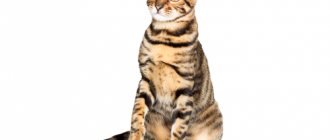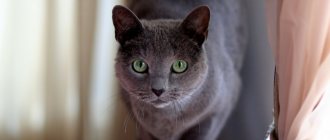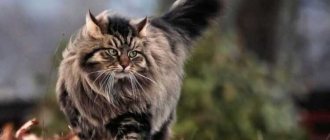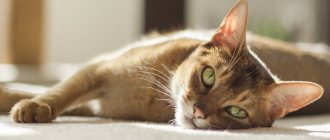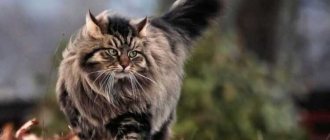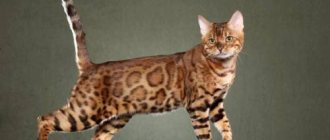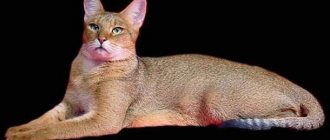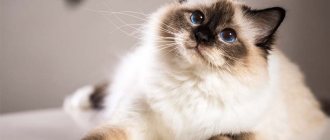Review author: “ZooVita”
Among lovers of exotic cats, the Burmese cat is of particular interest, which is easy to recognize in the photo: a queen with a chocolate-colored coat, bright golden eyes and a magnificent character.
This breed began its origins in ancient sacred temples in Myanmar, where cats were revered as sacred animals. Cat owners note their pets' friendly nature and special prudence.
Raising the Burmese cat breed
Cats of this breed are distinguished by their attachment to their owner, whom they are ready to relentlessly follow for days on end. Before getting a Burmese, the future owner should familiarize himself with the following features:
- These animals are quite impressive in size, but do not lose their grace and flexibility.
- From childhood to old age, cats will remain playful and require active activities from the owner.
- When choosing a kitten, you should check with the breeder what type of cat - American or European - is represented in this case. There are several external differences between the two subspecies.
- The animal has a very developed intuition, which allows the cat to quickly determine the mood of the owner.
- All representatives of this breed are quite unpretentious in care and maintenance.
- They can easily tolerate noisy games, including with children.
These mysterious animals with golden eyes are easy to train. The question of how much a Burmese cat costs is ambiguous, and depends on the type of cattery, variety (American or European type).
Origin story
Interesting moment! In ancient times, these cats were kept in Buddhist monasteries, where they were held in high esteem. The monks believed that these cats could not only cope with the task of catching rodents, but could also protect and protect people from the influence of evil spirits.
The history of this unique breed goes back to the distant past and this is not at all surprising, although modern Burmese cats are somewhat different from their ancestors.
These cats appeared in Europe in 1871 at one of the cat exhibitions. Despite the show, the Burmese cat did not impress anyone and was forgotten about for a long period of time. A little more than half a century later, Joseph Cheeseman Thomson brought the Burmese cat to San Francisco from Southeast Asia.
She was crossed with a Siamese cat and as a result, a still completely imperfect, but different breed of cat called “Burma” saw the light of day. After eight years of hard work by breeders, the breed acquired the desired qualities with approved standards.
General characteristics of the Burmese cat breed
All cats of this breed are distinguished by their heavy weight and powerful body. The average weight of an adult reaches 4.5 kg (for cats) and 3.5 kg for females.
The difference between the European type and the American one lies precisely in the structure of the body. Americans are more likely to have a massive frame and well-developed muscles.
Talisman giving happiness
In the Middle Ages and later, the Burmese became a talisman in wealthy families: aristocrats and rich people believed that it brought happiness and prosperity to the house. Therefore, they were surrounded by honor and care even in royal houses.
In the 19th century, the Burmese appeared in Europe - it was brought as a “dark Siamese”, and then breeders developed an independent breed: the Burmese were defined as a separate breed.
Due to numerous genetic crosses, they have partially lost their external aristocracy, but what was inherent in the genes cannot be taken away - elegance and self-esteem are in their blood.
Now there are 2 types of the breed: European and American Burmese.
Features of the European breed:
- triangular face - narrowed;
- ears - longer, closer located;
- paws – longer;
- the look is more cunning.
Honey-yellow or yellow-greenish eyes, a flat back and a medium-length thin tail - this is what every Burmese has.
And another amazing property of the fur: it is soft, silky and practically without undercoat.
But it has a strange property - when it’s cold, the fur darkens, and when the air temperature in the room is warm, it becomes lighter.
The Burmese looks elegant and graceful, and it weighs quite a lot - seals can weigh up to 10 kg, cats a little less - a kind of pebble wrapped in silk fabric.
And yet they are extraordinary - magical eye color, silky “fur coat”, angelic character.
The color of the pussies is also unusual - the back is darker than the belly. Common colors:
- sable – chocolate shade of fur, can vary from light milky to chocolate;
- chocolate - the difference from sable is that the males have darker ears and muzzles, and the paw pads and nose are a dark shade of chocolate or cinnamon;
- lilac is the rarest and most delicate color;
- blue - a little more common, somewhat reminiscent of Russian Blues or British Blues, but lighter than British Blues, and the paw pads are also soft blue;
- tortoiseshell - combining several shades at the same time.
Appearance of the Burmese cat breed
- Short hair that fits tightly to the animal's body. There is no undercoat. Stroking a cat of this breed is comparable to stroking silk.
- Smooth muzzle with clearly defined nose and zygomatic arches.
- The triangular-shaped ears are located quite far from each other. There are rounded tips, which are also tilted forward.
- All representatives of the breed have large eyes with a characteristic eastern slope of the top line. The iris is richly pigmented, which gives the eye an interesting color: from copper to amber. As we age, pigment synthesis decreases, and the color of the iris loses its saturation.
- Cats of this breed are characterized by an interesting detail - the lower jaw is larger than the upper jaw, and slightly pushed forward.
- Thin and long neck.
- The tail is of medium length and is characterized by a complete absence of bends.
- The limbs are thin, but with elastic muscles. The paws are gracefully shaped, there are 5 toes on the front paws, and only 4 on the hind paws.
All cats of this breed (regardless of type) are characterized by a darker coloring of the upper body. The classic coat colors are sable, platinum or lilac. Burmese cats of chocolate color are especially popular.
How to choose a kitten
Burmese kittens are born small in appearance and parameters and look small at 3 months. At first, the babies are all white and the main color will develop when they are one year old.
When choosing, they evaluate the appearance of the kitten; it should not be thin, but active. Examine the eyes, ears, anus. A healthy baby does not have gray-yellow discharge, and the stomach is not swollen and soft.
If possible, examine the cat's mother and the family's habitat.
Before selling kittens, breeders vaccinate kittens according to age, wean them from mother's milk and transfer them to independent feeding.
In the nursery, a complete package of documents with a veterinary passport and a registered pedigree will be prepared for a Burmese kitten. When studying the composition of ancestors, they make sure that there are no hereditary diseases in the line.
Important! It is recommended to buy an elite breed of Burmese kitten from licensed nurseries, which guarantee that the baby will not have hereditary diseases.
Burmese kittens photos
How much does a Burmese kitten cost?
The cost of the Burmese breed depends on the nursery and its pedigree.
- Pet class kittens. Those with deviations from the standard and castrated cost up to 15 tr.
- A breed class pet with a good pedigree for subsequent breeding of offspring costs more, ranging from 15 to 35 thousand rubles.
- Elite show class kittens, future winners of exhibition shows, cost over 35 thousand rubles.
Nurseries
There are not very many nurseries in Russia and neighboring countries. The popularity of the Burmese cat breed in the country is still gaining momentum.
- Moscow, Russia. Cattery "Burma Aldis", Burmese cats.
- Contacts; https://www.burma-aldis.ru/.
- Russia, Moscow. Cattery "O'KLER" Burmese cats.
- Contacts: +7 964 519-0517 [email protected] ://www.okler.ru/
- Saint-Petersburg, Russia. Cattery "Bourimea*RU" Burmese cats. System: FIFe
- Contacts: +7-921-421-79-09; e-mail; https://www.bourimea.ru/
- City: Riga (Latvia). Cattery "LV*Malsan" Burmese cats. System: FIFe.
- Contacts: +371 29127603; e-mail; www.malsan.lv
Health of the Burmese cat breed
The most common defects include the following stigmas:
- Brindle-like stripes on the limbs.
- The muzzle is elongated.
- Rounded eye shape.
- Crook in the nose.
- Malocclusion.
- Atypical color of the iris, such as green or blue.
- Excessively long hair.
Congenital pathologies include strabismus and deafness.
Health and diseases
Representatives of this breed are in good health, but may suffer from hereditary diseases.
In addition, they may experience:
- Difficulty breathing.
- Copious secretion of tear fluid.
- Curvature of the skull.
- Tail deformity.
You need to remember to constantly visit the veterinarian and vaccinate the animal, even if the animal is constantly at home. There should be an anthelmintic agent at home.
Character and habits of the Burmese cat breed
The character of the Burmese cat is characterized by a cheerful and cheerful attitude. They love to communicate with the owner, children and all family members. Pets remain active until old age.
Cats are very sensitive to changes in a person’s mood, and will try to play, run after a sunbeam, or try to get under the blanket with a person.
Tips for choosing a kitten
To make a safe purchase, avoid bird markets and free classified ads posted online. Opt for large nurseries with good reviews, ready to confirm the legality of their activities with all the necessary documents. The only disadvantage of such establishments is the high price for furry pupils.
Burmese kittens up to 3 months old are up for sale. If you want to buy a show-class pet, then choose an animal over 1 year old. Until this age, light brown tints in the sable color are acceptable, which interferes with an adequate assessment of the exterior. The final cost of the kitten consists of the costs incurred and compliance with the standard.
When choosing a kitten, consider:
- Appearance of a kitten. Have a preliminary consultation with a felinologist or an experienced breeder. Take a photo with you to make sure the exterior matches, and carefully examine the kitten for possible pathologies. A disheveled appearance, red or watery eyes, an unsteady gait and a bloated tummy are warning signs that indicate a sick animal.
- Parents' appearance. Pictures posted on the Internet do not always correspond to reality. Insist on meeting your parents in person to prevent miscegenation.
- Provided documents. The seller is obliged to provide the buyer with a sales contract and breeding documents confirming the origin of the kitten and its parents. If the kitten is more than 3 months old, then a veterinary passport containing notes on vaccinations is added to the listed documents.
The danger of buying a mixed breed lies not so much in non-compliance with the standard (which is not scary if you did not intend to participate in exhibitions), but in the likelihood of buying an animal with genetic diseases.
Rules for caring for the Burmese cat breed
Among all purebred cats, these pets amaze with their unpretentiousness in daily care. It is enough to comb the coat once every 7-8 days. The absence of undercoat is an advantage, because there is no frequent shedding.
Every day you need to wipe the coat with a damp cloth to remove loose hairs and dirt. Only in case of severe pollution (for example, a walk on a dusty balcony) should you buy a cat with a special shampoo. Such compositions are distinguished by their mild action and high-quality nutrition for short hair.
Training
Most cats have high intelligence, but Burmese cats are leaders in terms of development.
They can even be taught simple commands to “sit”, “lie down” and fetch things.
- For proper execution of commands, the cat should be encouraged with a tasty treat.
- When training, it is important to have patience and not shout at the animal, otherwise this threatens the owner with a complete refusal to carry out commands.
- Representatives of this breed can be easily litter box trained and will not cause any trouble.
Rational nutrition of the Burmese cat breed
If there are no problems with daily care, then the organization of a balanced diet should be approached with detailed attention.
The best option would be to purchase premium dry food, where all the necessary minerals, vitamins, and nutrients are in optimal proportions. It is sometimes recommended to introduce solid food into your cat's daily diet to prevent the formation of tartar.
If you feed your pet with regular food products, you should immediately exclude the following ingredients:
- Legumes.
- Mushrooms due to toxic effects on the pancreas.
- Pork is a clear example of fatty meat.
- Tomatoes, garlic and onions, spices, smoked products.
For drinking, use only filtered water, but not boiled water (high risk of kidney stones). All products are placed only on clean dishes. It is advisable to disinfect the drinking bowl and food bowl every day, followed by rinsing with hot water.
Care and maintenance
Shorthaired Burmese cats are not susceptible to hereditary diseases and require virtually no special care:
- A short coat with almost no undercoat can be cleaned once a week with a soft rubber brush and during shedding, use a furminator.
- To give the coat a shine, the cat's skin is rubbed with suede. It becomes irresistible and silkier.
- Cats are bathed only before a show. On normal days, it is enough to wipe the stained areas with a damp cloth.
- For a playful Burmese, it is useful to buy a set with a soft bed and a scratching post. If necessary, the claws are trimmed using a nail clipper.
- Ears and eyes require constant attention. The ears are cleaned of dust and wax, and the eyes are wiped in case of tearing characteristic of the breed.
Important! If gray, purulent discharge appears from your pet's eyes, you should consult a veterinarian; self-medication is not acceptable.
- It is not recommended to overfeed your cat; obesity can lead to diabetes.
- To avoid missing gingivitis, regularly clean the animal's teeth and mouth.
Diet
For the Burmese cat, which belongs to an elite breed, ready-made, balanced, industrially produced food is more suitable. Premium and super-premium class complexes selected taking into account the pet’s breed, age and physiological condition will help maintain health, physical activity and, as a result, prolong life.
Important! By receiving the required amount of vitamins and minerals, the Birman will maintain a silky, shiny coat.
Especially useful are the foods recommended for the prevention of diabetes, which Burmese cats often suffer from. These types of food include: Hill's PD Feline W/D 9191i and Pro Plan After Care. Alternating soft canned food with harder dry food will reduce the appearance of tartar and improve the functioning of the gastrointestinal tract.
When including natural homemade food for the Burmese cat breed in the diet, the following proportions must be observed:
- Protein food up to 70%, consists of meat: veal, rabbit, poultry, chicken, turkey and offal daily;
- Carbohydrate food up to 20%, consists of various cereals and vegetables daily;
- Fats up to 5%, in the form of chicken, quail yolks, cottage cheese and fermented milk products 2 times a week;
- A complex of vitamins, minerals, and fiber include up to 5% daily.
Important! With both types of food, the pet must have 24-hour access to fresh bottled water.
Health and diseases
Burmese cats are relatively healthy creatures, but throughout their lives they can be subject to breed-specific diseases:
- Diabetes mellitus is a chronic disease common in obese cats, so dietary restriction is recommended.
- Hypokalemia is characterized by low levels of potassium in the blood, which is caused by a genetic pathology passed on from parents.
- Gangliosidosis causes hereditary damage to the nervous system.
- Parentally transmitted flat chest syndrome.
- Tearing due to the unusual structure of the eyes.
- Gingivitis causing the appearance of tartar.
A healthy diet, attentive care and careful selection of parents when mating will allow the Burmese cat to live until its 15th birthday.
Important! Vaccinate in a timely manner and use anthelmintic drugs at least 2 times a year. Protect your cat from blood-sucking parasites: ticks, fleas, lice.
Interesting facts about the Burmese cat breed
A special feature of cats of this breed is their well-developed immunity, which makes the pet resistant to a number of infectious diseases.
But still, some structural and metabolic features cause pathological conditions that the owner should be aware of:
- Labored breathing.
- Profuse lacrimation.
- Headaches due to severe deformation of the skull.
- Gum inflammation is one of the most common problems affecting Burmese cats.
Tail defects can make a cat clumsy and slow to move. Prevention of helminthiases is mandatory in the dose calculated by the veterinarian (and only with drugs acceptable for this purpose).
Nurseries
In Russia, most nurseries offer kittens of the European variety; the American Burmese is found in Moscow (BeautyBurm), Yekaterinburg (Wildangel), Samara (Rangpurcat) and Chelyabinsk (BurMau).
Before purchasing, you should ask the nursery for a photo of the Burmese cat (mother) in order to understand the color option of the future baby.
In Moscow, nurseries offer European Burmese kittens:
- BurmaVilla, which features lilac, sable, and chocolate kittens;
- risingsun;
- Jasper Burmese, selling sable offspring;
- Tanaka, there is a rare red Burmese here.
There are few Burmese catteries in St. Petersburg:
- La griffe aigue *RU;
- Secret Pleasure;
- Luxurious Dream's.
Photos of all colors of the Burmese cat
Castration and sterilization
If a cat or cat is not intended for breeding, then they should be spayed or sterilized.
At what age is it recommended to sterilize an animal?
In the past, it was recommended that spay and neuter surgeries should not be performed until the female cat reached eight months of age. However, early castration is now increasingly being performed - at approximately 4 months of age. Experienced breeders, selling kittens as pets at 16 weeks of age, give the new owner an already sterilized cat or neutered cat. Sterilization is effective both at 4 and 8 months.
Caring for your pet after surgery
After the operation, the cat is put on a special blanket that will protect the seam from licking. The cat owner makes sure that the pet does not have hypothermia, and that there is clean water nearby. If your pet does not drink, then she must be given water forcibly, through a syringe without a needle. You can feed on the second day after surgery, offering the animal a portion three times smaller than usual. On the third day, you can switch to your normal diet.
The blanket is not removed from the cat until 2–3 days have passed after the sutures have been removed, which usually occurs 7–10 days after surgery. Until the seam heals, the owner will have to carefully monitor the cat’s condition, treat the seam with an aseptic solution once a day, and provide warmth for the pet. When the sutures heal (and this depends on the individual characteristics of the cat and its absence of concomitant diseases).
A cat after castration requires much less attention from its owners. The incision is minimal (about 1 cm), and there are no stitches. The owner needs to provide the cat with warmth, drink and rest. Usually the cat is given a special collar to prevent licking. Drinking and feeding are carried out according to the same scheme as for a cat after sterilization. Healing usually proceeds quite quickly, and after 2-3 days the cat returns to its normal lifestyle.
Owner reviews
Advantages: Affection Disadvantages: they are good, no disadvantages My parents had a lilac cat from the beginning, Izya. He fell in love with my mother and never left her side. When she left on business, he screamed heart-rendingly, cried and suffered under the door. He hated me terribly, I don’t know why, but still. After two years of unpretentious life, he died unexpectedly. Mom was hysterical. But after moving away from the tragedy, I decided to take a Burmese again, but this time chocolate-colored. It was a wonderful, very beautiful cat, Cupcake. But as it turns out, this breed has huge health problems. And after castration at 8 months, Kex became very ill with his stomach. The food was not digested, and there were attacks when the cat fell and suffocated. Doctors gave the cat a maximum lifespan of a week or two. He lay there and died quietly. His mother was hysterical and seemed to die along with him. My heart couldn’t stand it and I came and took him from my mother’s hands and took him to be euthanized. It was very difficult and scary. But this torment had to stop. Now my husband and I gave our mother a Bengal and they are happy. The Burmese is a very good cat, but our experience with this breed was not successful. Buy this breed but only from trusted nurseries. So as not to suffer later. Burmese are affectionate and very attached to people.
Yulia1411
https://otzovik.com/review_777085.html
Burmese cat - Love without borders! Advantages: Endless Disadvantages: The breed is not cheap Let me start with something not very pleasant... I have never liked cats (cunning, fluffy ones...). Everything changed after my mother persuaded me to give her Burma for her birthday!) This is a real cat dog! This is a creature of unreal beauty and unreal devotion! The Burmochka will follow you with its tail, caress, purr, “talk”, will show off its playfulness in front of you, behaves very dignified when going to the doctor, this breed is very talkative, but does not walk and squeal without a reason, such intelligence There is simply no limit to the cats. With such excellent content, this happiness is also beautiful, almost non-shedding, non-smelling, and not picky in food, but you won’t want to skimp on such magic. BUT!!! This breed should not be left alone. The Burma is very vulnerable, touchy, and characteristic. Alone, he will fall into terrible depression. If you spend enough time at home and are ready to spend it communicating and playing with a cat, or you have children, or you are alone and you need the most faithful friend... The Burmese cat is your cat. You will never regret spending money on this full-fledged member seven!
LOMAKINANA
https://otzovik.com/review_3601261.html
Advantages: neat, playful, sociable, beautiful colors, curious, muscular, adapts well to a new place, clean, silky fur Disadvantages: high price, looks funny as a kitten, cannot stand loneliness Luxury and grace. His Majesty Burma! Our pet is an important purebred person. The appearance of a cat is just a calling card. The trick is the incredibly beautiful fur. Smooth short shiny. Very similar to a mink coat. The downside is that all this beauty of the breed appears only when the cat grows up... He looks ridiculous as a kitten. Half-bald, of an incomprehensible color, “little runt.” Regarding character, I think it’s all individual. But if it is useful for someone, I can say a few words about the character of OUR pet: Sociable, playful, cannot stand loneliness; Easily finds a “common language” with guests; Clean (no problems with going to the litter box); Unfortunately, he suffers from the fact that he likes to chew furniture. The breed is quite rare, there are few breeders, so kittens are very expensive today. Conclusion: the breed is very beautiful and unusual. I definitely recommend taking a closer look.
J_u_l_i_a
https://irecommend.ru/content/o-glavnoi-fishke-burmanskikh-koshek

